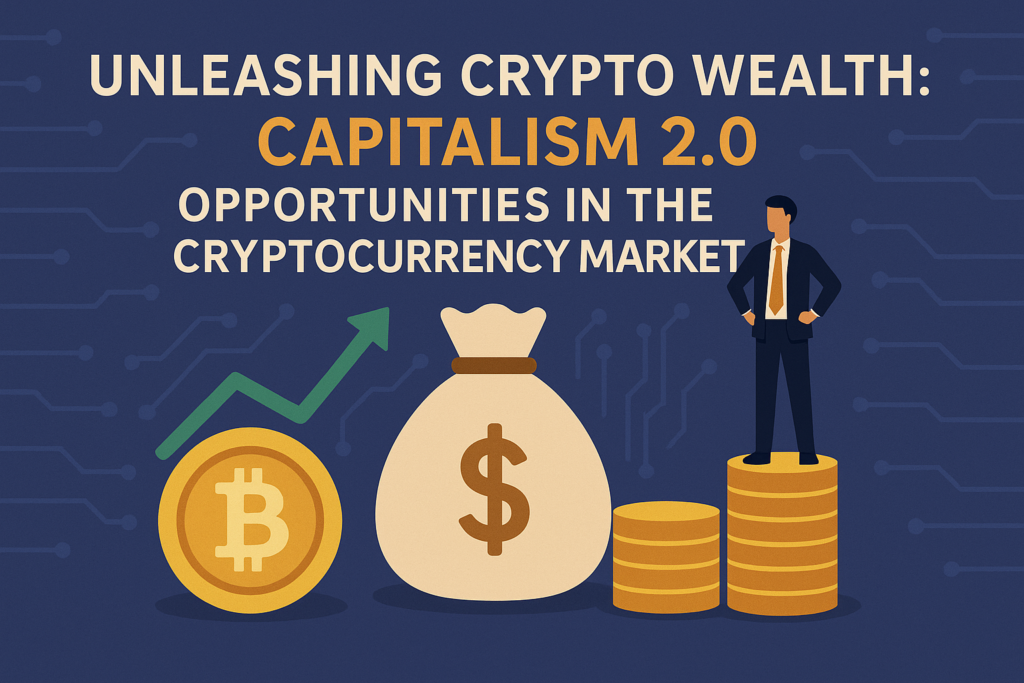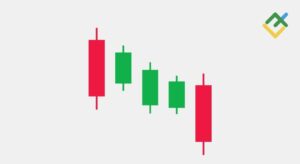Capitalism 2.0 Opportunities in the Cryptocurrency Market

Introduction
Traditional capitalism is experiencing a profound transformation, one that is redefining the very fabric of global financial systems. At the forefront of this seismic shift is cryptocurrency—a decentralized, borderless, and permissionless paradigm that operates beyond the control of traditional banking infrastructures and central governments. Cryptocurrencies are not just digital assets anymore; they have evolved into foundational elements of an emerging economic order that many are calling Capitalism 2.0.
This new financial architecture is driven by an ethos of open-source collaboration, decentralized governance, and blockchain-based transparency. Central banks are being challenged by algorithmic stablecoins. Wall Street is competing with decentralized autonomous organizations (DAOs). Institutional investment portfolios now include tokens, and venture capital is pouring billions into Web3 projects. As the lines blur between traditional and digital finance, it’s becoming clear that crypto is not a trend—it’s the next evolution of capitalism itself.
Investing in the Crypto Market
The cryptocurrency market is a highly dynamic ecosystem characterized by 24/7 trading hours, immense innovation, and often extreme volatility—all of which create both unparalleled opportunities and substantial risks for investors. The key to navigating this explosive environment lies in understanding its nuances and being able to identify asymmetric investment opportunities before they go mainstream.
Bitcoin (BTC) continues to be the gold standard of digital assets. As the first and most secure blockchain, it offers scarcity through its capped supply and attracts interest from both retail and institutional investors alike. Ethereum (ETH), with its support for smart contracts and thriving DeFi ecosystem, remains a high-conviction long-term hold. However, the most compelling alpha often lies beyond the blue chips—in emerging sectors and novel protocols.
Investors today are pouring capital into a range of next-generation projects such as Layer 2 scaling solutions that tackle Ethereum’s congestion and high transaction fees. Optimism, Arbitrum, and zkSync are gaining traction for enabling faster and cheaper transactions. Meanwhile, AI-integrated blockchain platforms like Fetch.ai and SingularityNET are creating synergistic environments where machine learning intersects with secure, decentralized data infrastructure.
The modular blockchain thesis is another strong narrative capturing investor attention. Networks like Celestia and Cosmos build composable ecosystems where components can be decoupled and customized, enabling faster innovation and higher performance at scale. Combine these with DAO-based governance models, and you’re looking at investment potential akin to early-stage tech startups—with added liquidity and community participation.
Understanding the Market Trends
Understanding macro and micro trends in the cryptocurrency space is essential for investors who aim to stay ahead of the curve. Several important movements are currently shaping the landscape, indicating a sustained and widespread integration of blockchain technology into mainstream finance.
First, the introduction of Spot Bitcoin ETFs in multiple jurisdictions marks a milestone in regulatory acceptance. These instruments have opened the door for institutional investment, providing exposure to Bitcoin without requiring direct custody. As inflows rise, so does market legitimacy, creating a flywheel effect that enhances mainstream adoption.
Another critical trend is the ongoing tokenization of real-world assets (RWAs). From tokenized real estate and equities to fractionalized art and bonds, blockchain technology is making traditionally illiquid assets tradeable in seconds. This unlocks capital efficiency and democratizes access to markets previously reserved for elites.
Decentralized Finance (DeFi) continues to evolve, now moving towards more sustainable yield mechanisms and refined tokenomics. Protocols are focusing on utility-driven staking, insurance against smart contract risks, and integration with real-world data sources through oracles. Additionally, compliance layers are being introduced to satisfy regulatory criteria without compromising decentralization.
NFTs are also undergoing a transformation. No longer just speculative art pieces, NFTs are being utilized in gaming ecosystems, intellectual property management, ticketing systems, and even decentralized identity solutions. This diversification is expanding their utility and reducing their volatility over time, making them a more compelling investment segment again.
Ultimately, as governments and regulators increase their involvement, crypto-native developers are responding with a renewed emphasis on decentralization and censorship resistance. This cat-and-mouse dynamic is driving innovation at a staggering pace—and keeping the market vibrant and investor-focused.
Maximizing Profits
To generate meaningful profit in the crypto space, investors must move beyond conventional strategies and embrace a contrarian, data-driven approach. Simple buy-and-hold tactics may yield modest returns, but the true potential lies in dynamic allocation, risk hedging, and capital deployment tailored to market cycles.
One core strategy is adopting a contrarian mindset. Profits often emerge from making informed moves when sentiment is at its lowest. History has shown that buying during market capitulations—when “fear” dominates social metrics and sentiment indicators—can yield exponential gains when market confidence returns. Conversely, taking profits during irrational exuberance can protect capital and allow reentry at lower prices.
Using on-chain analytics tools like Nansen, Glassnode, and Dune Analytics can offer invaluable insights into wallet activity, token supply changes, exchange inflows/outflows, and smart contract interactions. This data-driven approach can uncover accumulation patterns, early project momentum, and whale movements that often precede breakout rallies.
Decentralized exchanges (DEXs) provide early access to nascent tokens often before centralized listings. By utilizing liquidity pools, you can engage in yield farming, liquidity provision, and token staking—but always with a security-first mindset. Smart contract auditing, impermanent loss mitigation, and thorough whitepaper evaluation are essential to prevent common pitfalls.
Adopting strategies like dollar-cost averaging (DCA) into high-conviction assets during bearish periods allows investors to manage risk while building exposure gradually. Periodic rebalancing of the portfolio in bull markets can help lock in gains and maintain a diversified risk profile.
Being a successful crypto investor requires not only technical knowledge but also psychological resilience. Keeping emotions in check, staying paranoid about protecting private keys, and continuously educating oneself are critical. Remember, crypto markets don’t forgive complacency—but they do reward those who stay informed and act decisively.
Future Outlook
Looking ahead, the cryptocurrency landscape is poised for generational change. From the underlying plumbing of blockchain networks to the application layer impacting everyday users, innovation is happening at every level—and the opportunities for visionary investors are limitless.
One major area of growth is the rise of zk-rollups, a type of zero-knowledge proof-based scaling solution that enhances privacy and transaction throughput simultaneously. Projects like zkSync, StarkNet, and Polygon zkEVM are leading the charge and enabling entire dApps to move onto these scalable frameworks without compromising security.
Another emerging sector is DePIN (Decentralized Physical Infrastructure Networks). These projects leverage token incentives to bootstrap physical infrastructure—such as wireless networks, mapping systems, and energy grids—through user participation. Filecoin for storage, Helium for wireless coverage, and Render Network for GPU computing are early examples with massive potential.
The modular blockchain movement is also accelerating. Unlike monolithic blockchains, modular designs separate functions like consensus, data availability, and execution, enabling greater flexibility, scalability, and developer freedom. These systems can interoperate across chains, allowing ecosystems to scale horizontally without succumbing to bottlenecks.
Additionally, the integration of artificial intelligence with smart contracts will create more responsive and autonomous financial systems. AI agents can help with asset management, on-chain governance participation, and even yield-optimizing strategies tailored to risk profiles—that’s the future of self-driving economies.
As this digital renaissance unfolds, those who deepen their understanding, build conviction, and position early will witness outsized returns—both financially and intellectually. The future belongs to the builders, the researchers, and the early adopters.
Conclusion
We are witnessing the dawn of Capitalism 2.0—a decentralized, borderless, and open-source financial era no longer dictated by traditional gatekeepers. Powered by smart contracts, community-owned platforms, and self-sovereign assets, this new age favors those who embrace change, question orthodoxy, and act strategically.
Cryptocurrency is more than a financial tool—it’s a movement. A movement toward autonomy, transparency, and digital empowerment. By dedicating time to research, deploying capital with purpose, and navigating volatility with conviction, investors can unlock real wealth and personal financial sovereignty in a way no previous generation could imagine.
As centralized power fades and decentralized networks rise, the future belongs to those willing to explore it, invest in it, and build on it. Welcome to your first step toward the decentralized economy—welcome to the age of real crypto wealth.







